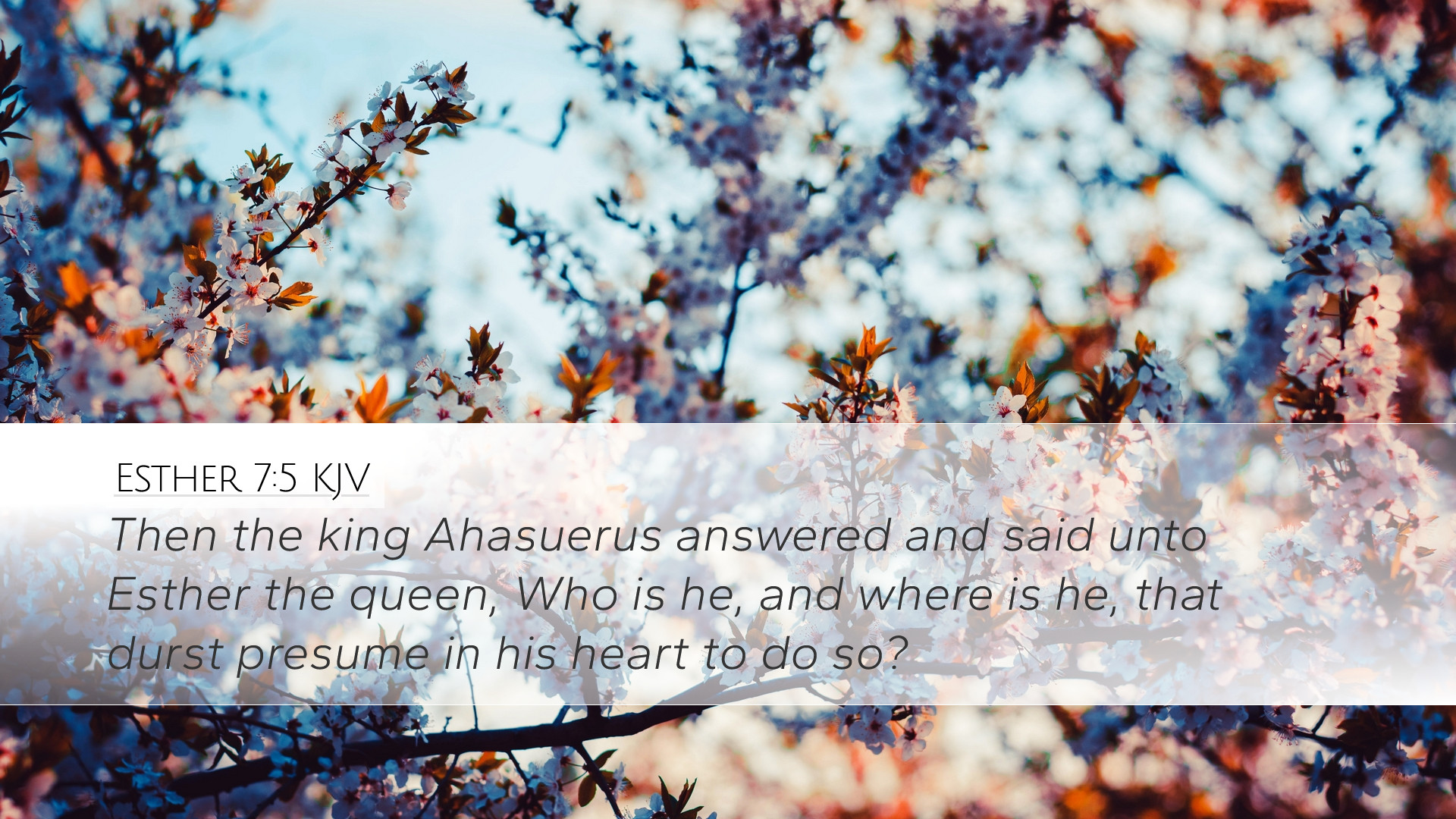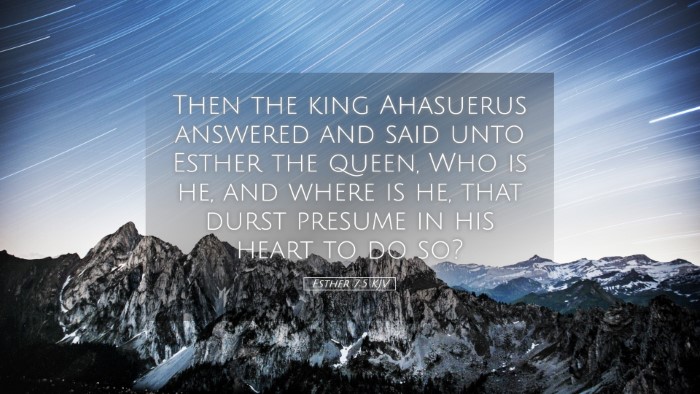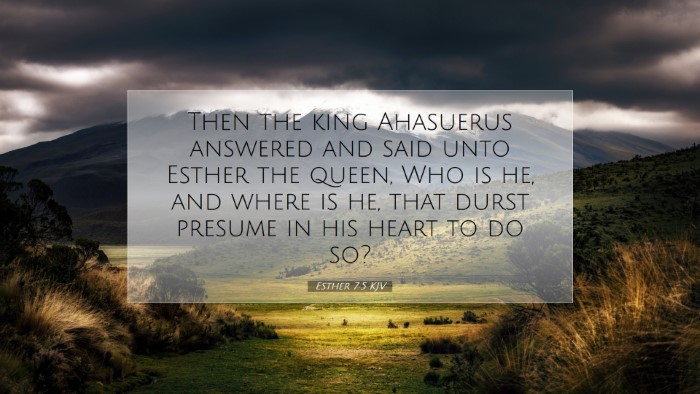Old Testament
Genesis Exodus Leviticus Numbers Deuteronomy Joshua Judges Ruth 1 Samuel 2 Samuel 1 Kings 2 Kings 1 Chronicles 2 Chronicles Ezra Nehemiah Esther Job Psalms Proverbs Ecclesiastes Song of Solomon Isaiah Jeremiah Lamentations Ezekiel Daniel Hosea Joel Amos Obadiah Jonah Micah Nahum Habakkuk Zephaniah Haggai Zechariah MalachiEsther 7:5
Esther 7:5 KJV
Then the king Ahasuerus answered and said unto Esther the queen, Who is he, and where is he, that durst presume in his heart to do so?
Esther 7:5 Bible Commentary
Commentary on Esther 7:5
Esther 7:5 records a pivotal moment in the narrative of Esther, where King Ahasuerus confronts Haman regarding the nefarious plot against the Jews. This verse is laden with tension and dramatic revelation; it serves not only as a turning point in the story but also as a rich source of theological reflection. Below, we explore insights from reputable public domain commentators.
Contextual Overview
In Esther 7, we witness the culmination of Esther's courageous intercession. The narrative unfolds as she reveals her Jewish identity to the king during a banquet. Haman, who has been plotting against her people, stands unsuspectingly near. The pressure of the moment culminates in the king's question, “Who is he, and where is he, that does presume in his heart to do so?”
Insights from Matthew Henry
Matthew Henry highlights the significance of divine providence in the events of Esther. He notes:
- God's Sovereignty: This verse demonstrates how God orchestrates events for His deliverance. Henry emphasizes that even an evil decree can be turned for good when God's people are obedient and faithful.
- Esther's Boldness: In her moment of truth, Esther bravely reveals Haman's plot, indicating her readiness to put her life on the line for her people.
- Judgment Upon Wickedness: Henry asserts that the request the king makes is laden with implications, signaling the inevitable judgment that falls upon Haman as the embodiment of evil in the narrative.
Insights from Albert Barnes
Albert Barnes sheds light on the linguistic and cultural nuances within the text:
- Rhetorical Devices: Barnes points out the king's rhetorical question serves to heighten the drama. His query indicates both outrage and a sense of betrayal, as he realizes the extent of Haman's treachery.
- Foreshadowing of Fate: The distinction between the king’s authority and the wickedness of Haman is a central theme. Barnes explains that the king's decree against Haman foreshadows greater themes of justice and retribution in the narrative.
- Understanding Authority: The king’s inquiry emphasizes the gravity of his authority and how it can be manipulated by those around him, such as Haman. This reveals the precarious nature of power when divorced from morality.
Insights from Adam Clarke
Adam Clarke's commentary offers a theological perspective as he examines the moral lessons embedded within this verse:
- Divine Retribution: Clarke discusses the theme of divine justice. He interprets the king’s inquiry not merely as a reactionary statement, but as a moment where justice is poised to prevail against Haman’s evil designs.
- Public Confession: Haman's exposure before the king is crucial. Clarke notes that his public downfall serves as a warning against pride and malice, thereby reinforcing ethical conduct.
- Role of Esther: Clarke elevates Esther's role as not only a Jewish heroine but also as an agent of divine justice. Her actions embody the intersection of faith and courage, encouraging believers to stand firm even against overwhelming odds.
Theological Themes
From a broader theological perspective, Esther 7:5 presents several key themes:
- God's Providence: This verse showcases the overarching theme of divine providence, where God works behind the scenes to protect His people, often in unexpected ways.
- Conflict Between Good and Evil: The confrontation serves as a microcosm of the larger battle between righteousness and wickedness, illustrating that while evil may seem to prevail temporarily, it will ultimately be judged.
- Redemption and Deliverance: The narrative not only offers the story of Esther but also reflects the redemptive work of God among His people, reminding theologians of the larger biblical narrative of salvation history.
Conclusion
Esther 7:5 serves as a profound reminder of courage, faith, and the ultimate justice of God. The insights from Henry, Barnes, and Clarke invite pastors, students, and theologians to delve deeper into the intricacies of the text, discerning its timeless truths. In reflecting on this passage, believers are encouraged to cultivate a stance of faithfulness and bravery, trusting that God's providence will guide them in moments of trial and confrontation.


